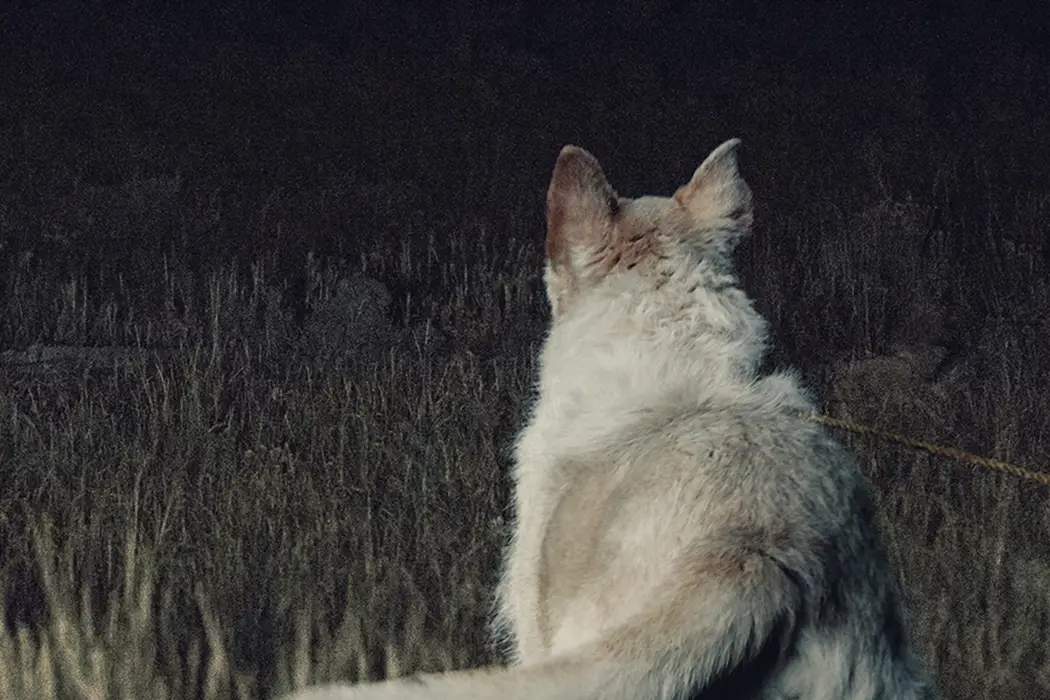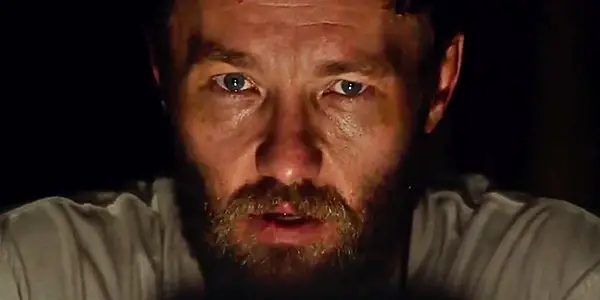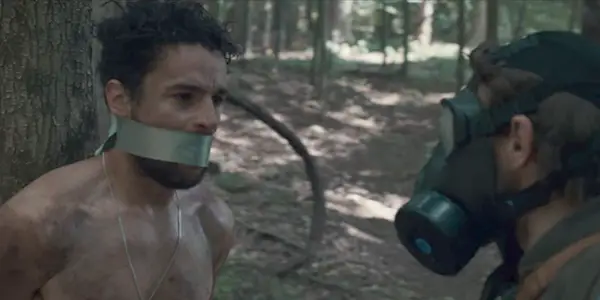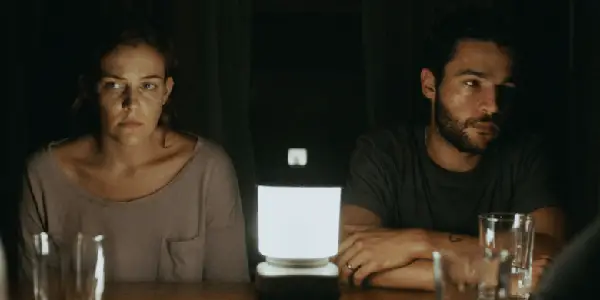IT COMES AT NIGHT: An Atmospheric, Disturbing Tale Of Paranoia

David is a film aficionado from Colchester, Connecticut. He enjoys…
“Paranoia strikes deep, into your life it will creep.” – Buffalo Springfield
Atmospheric horror films are often amongst my very favorites. With a preference for tone over dialogue, and spine-tingling scares as opposed to those more forthright in nature, the films, though perhaps not as scary upon initial watch, only bury deeper in your skin as time goes by. Most modern horror films, such as the Conjuring or Insidious series, ignore this approach, choosing instead to throw everything but the kitchen sink at you in order to provoke a reaction.
It’s the clear and defiant disregard for modern horror tropes that makes It Comes at Night such a refreshing watch. Trey Edward Shults, who last year helmed the similarly-toned Krisha, here creates a horror film more in the category subject-wise of last year’s The Witch; it is atmospheric, slow, haunting, and, by its conclusion, deeply and disturbingly relevant.
Tone is Everything
It Comes at Night concerns a single family living within a secluded house in the middle of the woods. The members of the family include Paul (Joel Edgerton), his wife Sarah (Carmen Ejogo), and their son Travis (Kelvin Harrison Jr.). Though we are never told exactly what has transpired out in the world, the understanding is that there was some sort of apocalyptic event that led to the family sheltering themselves away. Soon, a stranger (Christopher Abbot) comes upon their household, and though initially wary of his intentions, he, along with his family, including wife Kim (Riley Keough) and son Andrew (Griffin Robert Faulkner), are allowed to stay. After a time, though, tensions between the two families start to build, leading to the film’s climactic outcome.
In Shults‘ past film Krisha, the camera is maneuvered in various technical ways, including slow motion shots coupled with ambient music, drawn-out closeups of emotionless faces, and more. Though occasionally overused, it was effective in elevating a mostly simple character-driven drama into a rather gritty and disturbing horror film. Though ambiguous as far as setting itself, the story of It Comes at Night is also fairly simple; even going into it blind, you’re likely to guess where things will end up. What really distinguishes the film, then, is the manner in which it is told.

Trey Edward Shults is clearly a fan of horror, especially films such as the aforementioned The Witch. Much like that film used the surrounding woods as a character on its own, It Comes at Night utilizes the very best of its even more limited setting. Since the film takes place almost entirely within the confines of a single claustrophobic household, and, in addition, the house is not powered by electricity, there is ample potential for Shults and for director of photography Drew Daniels to let the camera cast its web.
Some of the more effective camerawork includes: long pans down dimly lit hallways, stark closeups of scared faces lit only by candlelight, dancing shadows in dark rooms, and, occasionally, quick zoom-ins to an unknown entity, which provide both the film’s goriest moments and also thankfully limited jump-scares. Driven also by Brian McOmber‘s heart-pounding score, It Comes at Night is often palpably tense.
Ambient noises are particularly effective at driving the film, and due to their constant up-and-down wavering, when they are suddenly absent the film becomes intensely silent. You’re not quite sure what is around the next corner, or if, as in some sequences, what you are witnessing is real or simply a nightmarish vision from one of the characters. To be fair, the “nightmare as reality” trope is a bit overdone, yet even though I eventually started to pick up on what was real and what was simply a dream, the practice still lends itself to the surrealness of the film’s tone.
Character, or Lack Thereof
As a film more driven by tone than its characters, few of the actors are actually given a chance to shine. The scenes between Abbot‘s Luke and Edgerton‘s Paul make for some of the more tension-wrought moments of the film (Edgerton is especially good at exuding confidence with limited dialogue), yet neither is really given much of a chance to express a range of emotion. Perhaps this is significant to the film itself; living within a dangerous world such as theirs, emotions can only get in the way – all that matters first and foremost is protecting one’s family.

If anything, the young Kelvin Harris Jr. is given the most opportunity to express his acting chops. Harris‘s Travis is doey-eyed yet also wise beyond his adolescent years. Despite this, he chooses to naively believe in the goodness of others, often in stark contrast to his immediately distrusting parents. As the window through which we glimpse this dystopian world, Harris’ performance is often understatedly effective.
The Red Door
It Comes at Night is notably ambiguous, even from its opening sequences. We don’t know what happened to the world such that the family would lock themselves away in the middle of the woods. And thankfully, unlike a particular M. Night Shyamalan movie, the answers are never fully provided. Instead, just as the circumstances of the setting are a mystery, so are the people who have now ventured into Paul and Sarah’s doors and are sharing a life within their walls.
Such ambiguity lends itself to the film’s ultimate takeaway: the nature of paranoia, and the very psychological understanding of fear, especially when it lends itself to an “other.” Though it seems as if nearly every movie could be attributed to our current political environment nowadays, It Comes at Night seems especially representative of it, especially when looking at rises in xenophobia fueled by the current presidency. In a clearly symbolic move by Shults, many of the characters are themselves minorities, including Paul’s wife and son who are African-American, and Luke, who is of Portuguese descent.

Ultimately, Luke and his family are seemingly harmless, yet the film doesn’t at first (or ever) expose the truth of their intentions. Shults doesn’t provide any definitive answers on either side, instead choosing to remain as stoic and unassuming as the stark red door so prominent in the film’s events. The door itself comes to symbolize this very tangible fear of paranoia, an ideal that lives within all of us despite our unwillingness to accept it. The conclusion of the film, for example, is both empathetic and outright horrifying; the only thing that seems to still understandably exist in this world is the darkness of the human psyche, which makes the film both disturbing and painfully self-aware.
Verdict
After seeing last year’s tension-riddled Krisha and witnessing what Trey Edward Shults was able to create on a shoestring budget, I was even more excited to see It Comes at Night. Though with more gory special effects, well-known actors, and high-tech cameras, the film still utilizes what made Krisha such a gripping watch: the raw, understated tension, the slow but steady pacing, and the haunting and mesmerizing use of sound and light.
It Comes at Night may not be for everyone, especially those that prefer the scare-a-minute modern horror films that still seem to swarm through the theaters, but in my opinion it’s all the better for it. Trey Edward Shults is, and hopefully will remain, a force to watch in horror cinema.
What did you think of It Comes at Night? What modern psychological horror films are amongst your favorites?
It Comes at Night was released in the United States on June 9, 2017. For all international release dates, click here.
Does content like this matter to you?
Become a Member and support film journalism. Unlock access to all of Film Inquiry`s great articles. Join a community of like-minded readers who are passionate about cinema - get access to our private members Network, give back to independent filmmakers, and more.
David is a film aficionado from Colchester, Connecticut. He enjoys writing, reading, analyzing, and of course, watching movies. His favorite genres are westerns, crime dramas, horror, and sci-fis. He also enjoys binge-watching TV shows on Netflix.













